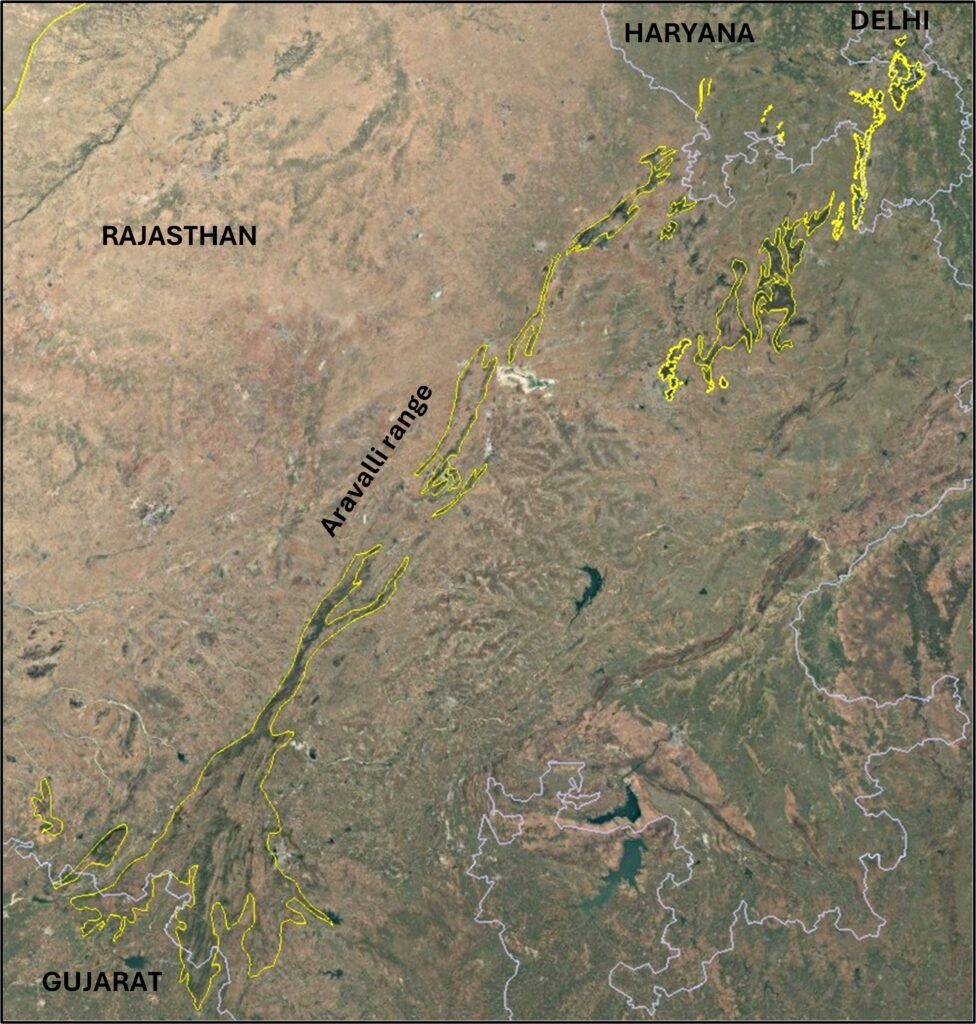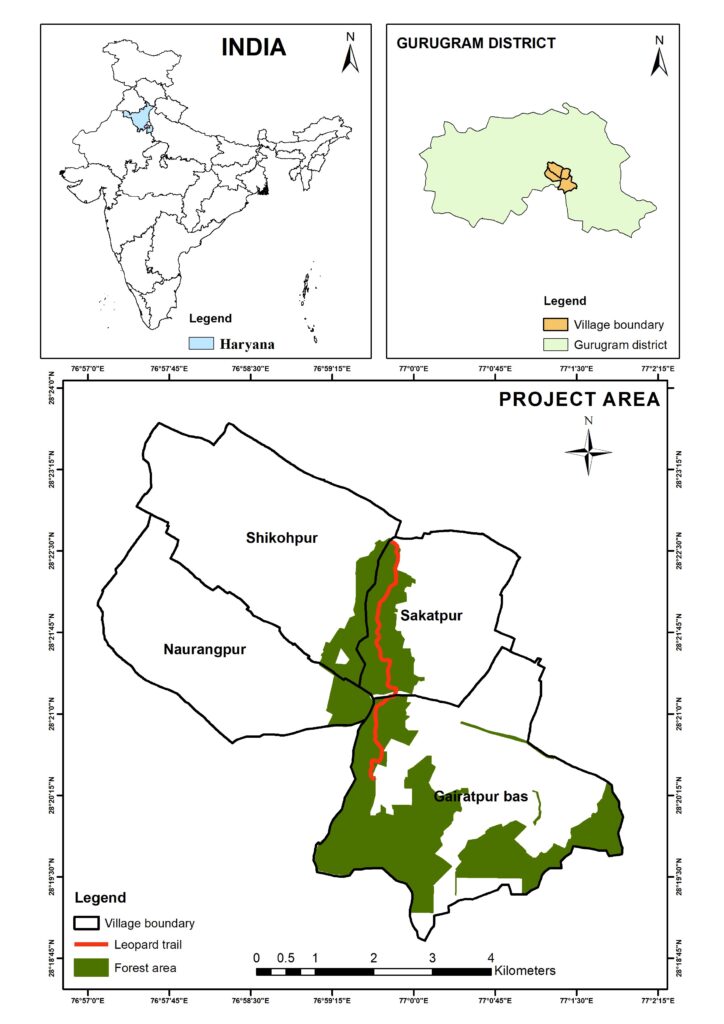The Aravallis: A Fading Green Legacy Amidst Urbanisation
I still remember the day I visited the Aravallis few years back with my family along the leopard trail. What struck me then wasn’t just the construction cranes or the shiny new office buildings, but the rugged, and fading green shadow of the Aravallis in the distance. They stood there, ancient and unassuming, like quiet ‘guardians of nature’ watching over a city in a hurry to outgrow itself.
Last year, I joined the Sankala Foundation working on the project on Eco-restoration of the Aravalli in Gurugram district.The Aravalli Range originates dating back over 2.5 billion years (Proterozoic era), making them one of the oldest geological features on the earth. It stretches approximately 692 km across 4 states – Gujarat, Rajasthan, Haryana, and Delhi (Fig. 1). Aravalli Range sustain millions of people directly or indirectly. From water security and agriculture to cultural heritage and livelihoods, this ancient mountain range is deeply intertwined with human survival in northwestern India.

Key Points
- Despite the Supreme Court has consistently ruled in favour of protecting the Aravallis, but due to weak enforcement by state governments has led to continued illegal mining and encroachments.
- Significant reduction in forest cover of about 50% within a span of just 20 years.
- Significant loss of biodiversity (native species of flora and fauna).
The Aravallis’ foothills and seasonal streams support crops like millet, mustard, and pulses in Rajasthan and Haryana. Tribal communities (Bhil, Meena and other tribes) are totally dependent on the Aravallis for their survival. It plays a crucial ecological role in preventing desertification, prevents soil erosion, supporting biodiversity, and recharging groundwater.
Aravalli Range acts as green lungs in several urban landscapes, playing a pivotal role in mitigating air pollution; supports the important drainage system (Sahibi River, Banas River, Luni River), and are extensive source for resources and minerals (metals like copper and zinc).
In the project, Sankala Foundation is developing a model for eco-restoration in Delhi NCR, to rehabilitate degraded lands, enhance biodiversity, and promote sustainable land-use practices. The project covers four urban villages – Sakatpur, Sikohpur, Naurangpur, and Gairatpur Bas of Gurugram district (within the vicinity of Aravalli Range) (Fig 2). This project is in collaboration with the Embassy of Denmark in India (India – Denmark: Green Strategic Partnership) and the local stakeholder – Haryana Forest Department.

- Conduct thorough surveys and assessments of the existing flora, fauna, and vegetation.
- Develop a plan for the eco-restoration of degraded forest lands in the Aravalli, focusing on afforestation, reforestation, sustainable management practices. and land
- Develop strategies implementation for eco-restoration to restore biodiversity and promote sustainable development.
- Contribute to developing a model for climate mitigation efforts.
Land degradation in the Aravalli Hills, particularly in Gurugram district (Delhi NCR), has reached alarming levels due to deforestation, illegal mining, rapid urbanisation, soil erosion, and unsustainable land use have led to severe land deterioration, threatening ecosystems, water security, and local livelihoods. Therefore, there is an urgent need for restoration in an ecologically sensitive area.
Aravalli Range acts as green lungs in several urban landscapes, playing a pivotal role in mitigating air pollution; supports the important drainage system (Sahibi River, Banas River, Luni River), and are extensive source for resources and minerals (metals like copper and zinc).
Since 1996, the Supreme Court of India (SCI) has passed several judgements in favour of the Aravallis, regarding complete ban on mining, ban on stone crushers within area of 10km of Aravallis, and banned the construction activities by the real estates. Moreover, in 2002, SCI recognised Aravalli hills as “forest land” under the Forest Conservation Act (1980). But, according to locals and as observed in the field, due to weak enforcement of laws and supreme court’s order by the state government and other stakeholders, still there are several cases of illegal mining and construction in the eco-sensitive area. If such practices of destruction continue, how can we save the Aravallis from vanishing?
The Concrete Jungle: An Assault of Urbanisation
The Aravallis in the Gurugram district are being paved by the rampant urbanisation. The foothills of the eco-sensitive are replaced by the high-rise buildings of real estate companies (Fig. 3). Moreover, the Golf Course Road and Delhi-Mumbai expressway (NH-48) has fragmented the Aravalli ecosystem. In the past decade, reckless felling of trees in the forest area resulted in a rapid conversion into the built-up area. According to the Forest Survey of India (FSI) reports, in Gurgaon, the forest cover has decreased by about 50% – from 229 sq. km. (in 2013) to 113.11 sq. km. (in 2023).

As a researcher, the loss of forest cover in the Aravallis, particularly around Gurugram, is deeply concerning from both an ecological and socio-environmental perspective. In the densely populated area like Delhi-NCR, the Aravalli range acts as the one and only natural barrier against the Thar Desert’s expansion into the fertile plains of North India. Deforestation in Gurugram and surrounding areas has led to: Increased air pollution (loss of green cover reduces particulate matter filtration); declining groundwater levels; and significant loss of biodiversity (native species).
When asked to the local villagers, they just mentioned we want our land and our Aravalli in the previous conditions i.e., lush green Aravalli with native species like Anogeissus pendula (Dhauk), Butea monosperma (Palash, Dhak), Azadirachta indica (Neem), etc., instead of only Prosopis juliflora (Vilayati kikar).
Will the Aravallis Survive?
The Aravalli Range is not just a geological marvel but a lifeline for millions. Land degradation in this region poses a severe threat to India’s ecological balance, water security, and climate resilience. Immediate action—through policy reforms, community engagement, and sustainable development—is essential to preserve this critical ecosystem for future generations. Sankala Foundation’s project represents a ‘science-backed, participatory model’ to reverse land degradation in the Aravallis. By combining ‘traditional knowledge with modern technology’, this initiative aims to restore ecological balance while empowering local communities. Moreover, this project will be an attempt to fulfil the prime objective of the “Aravalli Green Wall initiative” i.e. restoring about 1.50 million hectares of land in the Aravalli region.
Will the government act before it’s too late? Or we should act to protect the Aravallis? Or will Gurugram’s Aravallis vanish forever? Comment your thoughts!
Author
-

Dr Deepesh Goyal, Senior Research Associate is an environmental researcher with expertise in ecosystem recovery, sustainable development, and Nature-based Solutions (NbS). He earned his Ph.D. in Environmental Science from Guru Gobind Singh Indraprastha University, focusing on vegetation succession and soil recovery in Uttarakhand's landslide-affected areas. His skills include data analytics, geospatial tools like ArcGIS and QGIS, and statistical modelling like CCA, RDA for environmental assessments.
View all posts





